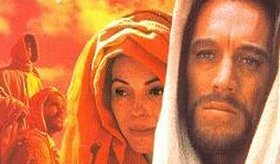
|
| |
| |
|
|
| |
|
|
| |
Greatest Story Ever Told
© Unknown - all rights reserved
|
| |
|
|
| |
 |
| Tookey's Rating |
|
|
4 /10
|
| |
| Average Rating |
|
|
4.33 /10
|
| |
| Starring |
Max Von Sydow  , Charlton Heston, Sidney Poitier , Charlton Heston, Sidney Poitier |
| Full Cast > |
|
|
|
| |
Directed by: George Stevens 
Written by: James Lee Barrett, George Stevens 
|
|
| |
|
|
| Tookey's Review |
|
| Pro Reviews |
|
| Mixed Reviews |
|
| Anti Reviews |
|
| Cast |
|
| |
 |
| |
| Released: |
1956 |
| |
|
| Genre: |
DRAMA
SO BAD
BIOPIC
|
| |
|
| Origin: |
US |
| |
|
| Length: |
260 |
|
| |
|
| |
|
|
| |
|
|
The life of Christ (Max von Sydow).
|
Reviewed by Chris Tookey
|
Despite the avalanche of critical contumely, this is an entertainingly bad film - with Max Von Sydow giving an extraordinarily dignified, yet passionate performance in the midst of much directorial and scenic vulgarity.
The best parts of it are early on, featuring Claude Rains, and were directed by David Lean; but all through there are splendid moments, thanks to the Oscar-nominated cinematography by George Mellor and Loyal Griggs, and the delighfully tasteless art direction by Richard Day and William Creber. There is fun to be had from spotting guest stars in hilariously inapposite roles - most famously, John Wayne popping up to say one line as the centurion at the Crucifixion.
The very loud but otherwise undistinguished score by Afred Newman was nominated for an Oscar. Winner of the Harvard Lampoon award as Worst Picture of the Year.
Sample line... "Aw, truly this is the Son of Gahd." |
(John Wayne, as Roman centurion at crucifixion)
|
ANTI
|
|
| Who but an audience of diplomats could sit through this thing? As the picture ponderously unrolled, it was mainly irritation that kept me awake. |
|
|
| (Shana Alexander, Life) |
|
| If the subject matter weren’t sacred in the original, we would be responding to the picture in the most charitable way possible by laughing at it from start to finish; this Christian mercy being denied us, we can only sit and sullenly marvel at the energy for which, for more than four hours, the note of serene vulgarity is triumphantly sustained. |
|
|
| (Brendan Gill, New Yorker) |
|
| A big, windy bore. |
|
|
| (Bruce Williamson, Playboy) |
|
| God is unlucky in The Greatest Story Ever Told. His only begotten son turns out to be a bore... George Stevens' direction is plodding and repetitious: whenever he has what he thinks is a fine shot, he is sure to repeat it several times; his groupings are studiedly picturesque, and a sequence like Christ's temptation in the wilderness is ludicrous throughout. Or take the scene in which the evils of everyday life are depicted in newsreel style with grainy photography, absurd in cinerama and color. Here a robbery, there a rape, yonder a murder - all taking place side by side along the main street, for Christ to look at, suffer and do nothing about. It is sheer nonsense. As for pacing, the picture does not let you forget a single one of its four hours for a moment. |
|
|
| (John Simon, National Review) |
|
| A Hollywood Reverential, a film so in awe of its subject that it dares approach it only in the most traditional terms at a slow and solemn pace. |
|
|
| (Judith Crist) |
|
| George Stevens was once described as a water buffalo of film art. What this film more precisely suggests is a dinosaur. |
|
|
| (Monthly Film Bulletin) |
|
| No more than three minutes of this new film have elapsed before we suspect that Stevens' name and fame have been purchased by the Hallmark Greeting Card Company and that what we are looking at is really a lengthy catalogue of Christmas cards for 1965 - for those Who Care enough to Send the Very Best. All the side lighting (dawn or sunset), back lighting (halo effects), picturesque groupings, and soda-fountain colors seem inspired by the soggiest nineteenth-century religious chromos; any self-respecting Victorian household would have been proud, sir, to hang any still from this film in its parlor. |
|
|
| (Stanley Kauffmann, 1965) |
|
| At times the scenery takes over and dwarfs the figures, but the panoramas are stunning. Perhaps Stevens was over-awed by his subject matter. His film is of excessive length - four hours including the intermission. And some of his commericial touches were entirely unnecessary, particularly the use of name stars... in small roles that could almost have been played by extras. |
|
| (Philip T. Hartung, 1965) |
|
|
|
|
|
|
